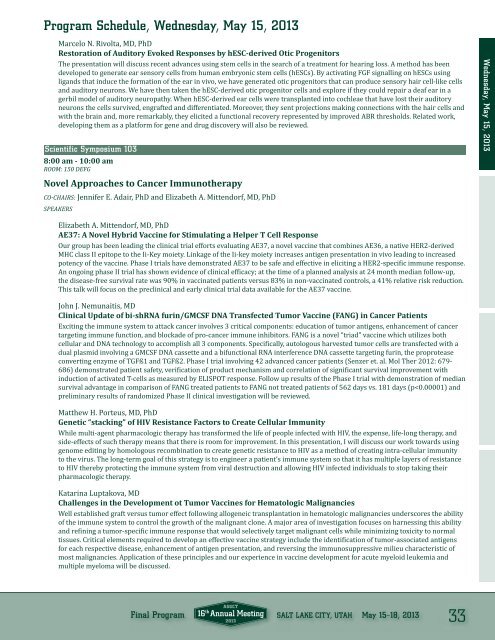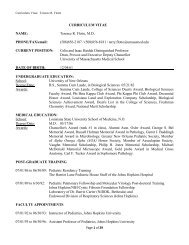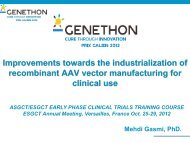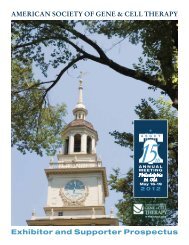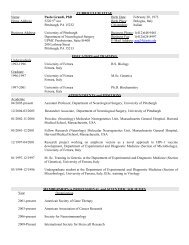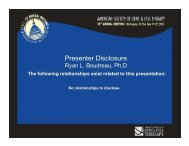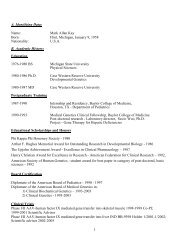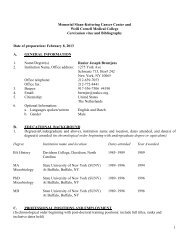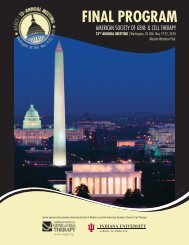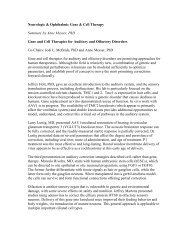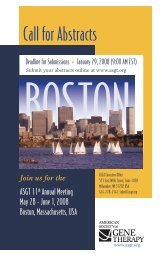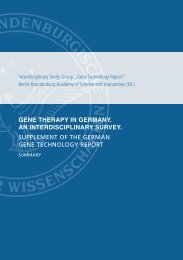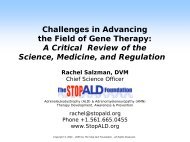Final Program - American Society of Gene & Cell Therapy
Final Program - American Society of Gene & Cell Therapy
Final Program - American Society of Gene & Cell Therapy
You also want an ePaper? Increase the reach of your titles
YUMPU automatically turns print PDFs into web optimized ePapers that Google loves.
<strong>Program</strong> Schedule, Wednesday, May 15, 2013<br />
Marcelo N. Rivolta, MD, PhD<br />
Restoration <strong>of</strong> Auditory Evoked Responses by hESC-derived Otic Progenitors<br />
The presentation will discuss recent advances using stem cells in the search <strong>of</strong> a treatment for hearing loss. A method has been<br />
developed to generate ear sensory cells from human embryonic stem cells (hESCs). By activating FGF signalling on hESCs using<br />
ligands that induce the formation <strong>of</strong> the ear in vivo, we have generated otic progenitors that can produce sensory hair cell-like cells<br />
and auditory neurons. We have then taken the hESC-derived otic progenitor cells and explore if they could repair a deaf ear in a<br />
gerbil model <strong>of</strong> auditory neuropathy. When hESC-derived ear cells were transplanted into cochleae that have lost their auditory<br />
neurons the cells survived, engrafted and differentiated. Moreover, they sent projections making connections with the hair cells and<br />
with the brain and, more remarkably, they elicited a functional recovery represented by improved ABR thresholds. Related work,<br />
developing them as a platform for gene and drug discovery will also be reviewed.<br />
Scientific Symposium 103<br />
8:00 am - 10:00 am<br />
ROOM: 150 DEFG<br />
Novel Approaches to Cancer Immunotherapy<br />
CO-CHAIRS: Jennifer E. Adair, PhD and Elizabeth A. Mittendorf, MD, PhD<br />
SPEAKERS<br />
Wednesday, May 15, 2013<br />
Elizabeth A. Mittendorf, MD, PhD<br />
AE37: A Novel Hybrid Vaccine for Stimulating a Helper T <strong>Cell</strong> Response<br />
Our group has been leading the clinical trial efforts evaluating AE37, a novel vaccine that combines AE36, a native HER2-derived<br />
MHC class II epitope to the Ii-Key moiety. Linkage <strong>of</strong> the Ii-key moiety increases antigen presentation in vivo leading to increased<br />
potency <strong>of</strong> the vaccine. Phase I trials have demonstrated AE37 to be safe and effective in eliciting a HER2-speciic immune response.<br />
An ongoing phase II trial has shown evidence <strong>of</strong> clinical eficacy; at the time <strong>of</strong> a planned analysis at 24 month median follow-up,<br />
the disease-free survival rate was 90% in vaccinated patients versus 83% in non-vaccinated controls, a 41% relative risk reduction.<br />
This talk will focus on the preclinical and early clinical trial data available for the AE37 vaccine.<br />
John J. Nemunaitis, MD<br />
Clinical Update <strong>of</strong> bi-shRNA furin/GMCSF DNA Transfected Tumor Vaccine (FANG) in Cancer Patients<br />
Exciting the immune system to attack cancer involves 3 critical components: education <strong>of</strong> tumor antigens, enhancement <strong>of</strong> cancer<br />
targeting immune function, and blockade <strong>of</strong> pro-cancer immune inhibitors. FANG is a novel “triad” vaccine which utilizes both<br />
cellular and DNA technology to accomplish all 3 components. Speciically, autologous harvested tumor cells are transfected with a<br />
dual plasmid involving a GMCSF DNA cassette and a bifunctional RNA interference DNA cassette targeting furin, the proprotease<br />
converting enzyme <strong>of</strong> TGFß1 and TGFß2. Phase I trial involving 42 advanced cancer patients (Senzer et. al. Mol Ther 2012: 679-<br />
686) demonstrated patient safety, veriication <strong>of</strong> product mechanism and correlation <strong>of</strong> signiicant survival improvement with<br />
induction <strong>of</strong> activated T-cells as measured by ELISPOT response. Follow up results <strong>of</strong> the Phase I trial with demonstration <strong>of</strong> median<br />
survival advantage in comparison <strong>of</strong> FANG treated patients to FANG not treated patients <strong>of</strong> 562 days vs. 181 days (p


